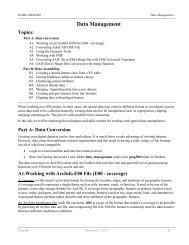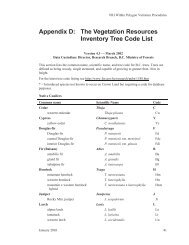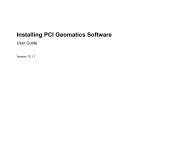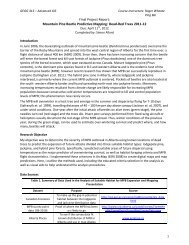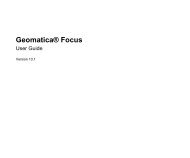Understanding Map Projections
Understanding Map Projections
Understanding Map Projections
Create successful ePaper yourself
Turn your PDF publications into a flip-book with our unique Google optimized e-Paper software.
planar projection<br />
A form of projection where the earth is projected onto a<br />
conceptual tangent or secant plane. Usually, a planar<br />
projection is the same as an azimuthal projection (Snyder<br />
and Voxland, 1989).<br />
polar aspect<br />
A planar projection with its central point located at either<br />
the North or South Pole.<br />
prime meridian<br />
A meridian of reference that defines the origin of the<br />
longitude values, 0° east or west.<br />
projected coordinate system<br />
A reference system that defines the locations of points on<br />
a planar surface.<br />
radius<br />
The distance from the center to the outer edge of a circle.<br />
reference ellipsoid<br />
See ellipsoid.<br />
rhumb line<br />
A complex curve on the earth’s surface that crosses every<br />
meridian at the same oblique angle; a straight line on the<br />
Mercator projection. Also called a loxodrome (Snyder and<br />
Voxland, 1989).<br />
scale factor<br />
A value (usually less than one) that converts a tangent<br />
projection to a secant projection. Represented by ‘k 0<br />
’ or<br />
‘k’. If a projected coordinate system doesn’t have a scale<br />
factor, the standard point or lines of the projection have a<br />
scale of 1.0. Other points on the map have scales greater<br />
or lesser than 1.0. If a projected coordinate system has a<br />
scale factor, the standard point or lines no longer have a<br />
scale of 1.0.<br />
secant projection<br />
A form of map projection where the conceptual surface<br />
of the projection (cone, cylinder, or plane) cuts through<br />
the earth’s surface.<br />
semimajor axis<br />
The equatorial radius of a spheroid. Often known as ‘a’.<br />
semiminor axis<br />
The polar radius of a spheroid. Often known as ‘b’.<br />
sphere<br />
A three-dimensional shape obtained by revolving a circle<br />
around its diameter.<br />
spherical coordinate system<br />
A system using positions of longitude and latitude to<br />
define the locations of points on the surface of a sphere<br />
or spheroid.<br />
spheroid<br />
When representing the earth, the three-dimensional shape<br />
obtained by rotating an ellipse about its minor axis. This is<br />
an oblate ellipsoid of revolution, also called an ellipsoid.<br />
standard line<br />
A line on a sphere or spheroid that has no length<br />
compression or expansion after being projected.<br />
Commonly, a standard parallel or central meridian.<br />
standard parallel<br />
The line of latitude where the projection surface touches<br />
the surface. A tangent conic or cylindrical projection has<br />
one standard parallel, while a secant conic or cylindrical<br />
projection has two. A standard parallel has no distortion.<br />
State Plane Coordinate System<br />
A projected coordinate system used in the United States<br />
that divides each state into one or more zones to minimize<br />
distortion caused by the map projection. Also known as<br />
SPCS and SPC.<br />
tangent projection<br />
A form of map projection where the conceptual surface<br />
of the projection (cone, cylinder, or plane) just touches<br />
the earth’s surface.<br />
true-direction projection<br />
A form of projection that shows lines with correct<br />
azimuths from one or two points.<br />
unit of measure<br />
See angular units or linear units.<br />
Universal Transverse Mercator<br />
A projected coordinate system that divides the world into<br />
60 north and south zones, six degrees wide.<br />
104 • <strong>Understanding</strong> <strong>Map</strong> <strong>Projections</strong>




